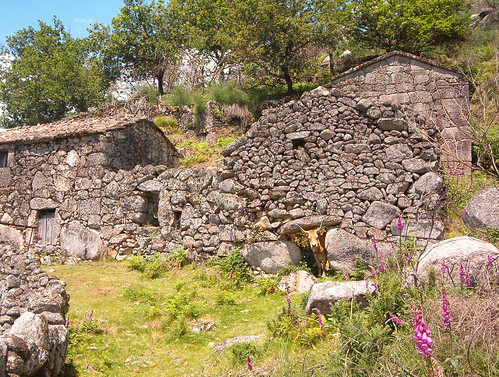
Informação / Information
Branda da Bordença

Na Serra de Soajo existe um tipo de povoamento muito típico: as Brandas e Inverneiras.
São núcleos habitacionais temporários cuja origem se prende com a necessidade das populações utilizarem os pastos localizados na serra para alimentar o gado. Este processo de transumância tem a ver com a garantia de alimentos e, consequentemente, com a sobrevivência humana.
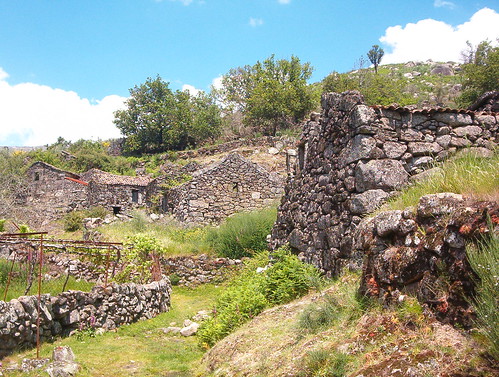
A Inverneira, como o nome indica, é a aldeia onde a família passa o Inverno. Localizam-se em vales, ou seja, em altitudes baixas. No princípio do Outono, as pessoas descem para a Inverneira permanecendo aí até Março. Nessa altura, sobem para a Branda, onde se fazem as sementeiras e onde se passa a maior parte do ano. Hoje em dia, nas poucas aldeias que mantêm a tradição, as pessoas apenas levam os animais e alguns haveres, ao contrário de antigamente, em que as pessoas levavam até a mobília. Por este motivo as Brandas e Inverneiras são, sem dúvida, um elemento importante da cultura da população destas serras.
Actualmente a maior parte da população acabou por se fixar definitivamente, na maior parte dos casos nas Inverneiras, abandonando de certa forma este estilo de vida. Por esse motivo, actualmente as brandas que ainda são usadas servem apenas para guardar alguns pertences e os animais nos meses mais quentes, estando muitas outras ao completo abandono.

O que é o caso da Branda da Bordença, situada nas imediações do lugar de Adrão e da Senhora da Paz na freguesia do Soajo.
Esta aldeia que antigamente era uma branda está neste momento completamente abandonada, à excepção de alguns campos de pasto. As casas antigamente habitadas pelo homem servem agora apenas de refugio a alguns animais.
Aqui vai puder caminhar livremente pelas antigas casas e campos e rever o modo de vida das antigas populações. (Fontes 1, 2, 3, 4, 5 e 6)
Deixo também algumas palavras de um antigo residente de Adrão o Ventor, se gostam de memorias de alguém que viveu nestas serras aconcelho a leitura dos seus sites:
"Que posso eu dizer sobre Bordença? Tal como a Assureira, Bordença é também uma branda, e a saudade das suas gentes! As suas montanhas, sempre a trepar rumo ao céu, eram o local ideal para as grandes vezeiras de cabras. (..)
(...) Como eram perigosos os montes de Bordença! Já não me recordo dos nomes dos seus montes, mas ainda os tenho na minha retina, quer a subir quer a descer. Nesses tempos as cabras comiam tudo e não era difícil caminhar sobre eles, quer pelas rochas, quer pelos matos, quer pelos trilhos, abertos à força da passagem dos animais e das pessoas.
Como são lindos e selvagens, os montes de Bordença e como era belo ver os lobos a trepar as fragas quando se apercebiam dos responsáveis pelo pastoreio das cabras. (..)"

In Serra de Soajo there is a very typical type of settlement: the "Brandas" and "Inverneiras".
These are temporary housing units whose origin lies in the need of people of this land to use the pastures located in the hills to feed the cattle. This process of relocation has to do with the need to guarantee food and therefore with human survival.
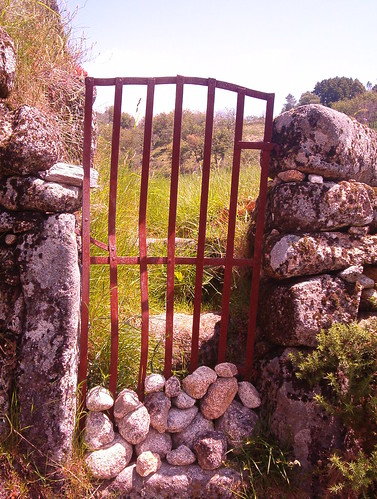
The "Inverneiras", as the name indicates (winter is "Inverno" in Portuguese), is the village where the family spends the winter. Located in valleys, or at low altitudes. In early fall, people come down to the "Inverneiras" and remain there until March. Then they go up to "Branda" (comes from "Verão, summer in Portuguese)", where the plantings are and where they spend most of the year. Today, in the few villages that maintain the tradition, people just take the animals and some assets, unlike before, where people took up all belonging's including the furniture. As such "Brandas" and "Inverneiras" are undoubtedly an important element of the culture of the people of this land.
Currently most people settled down permanently in most cases in the "Inverneiras", abandoning that lifestyle. Therefore, currently the "Brandas" that are still used only serve to save some belongings and animals in the warmer months, while many others are completely abandoned.
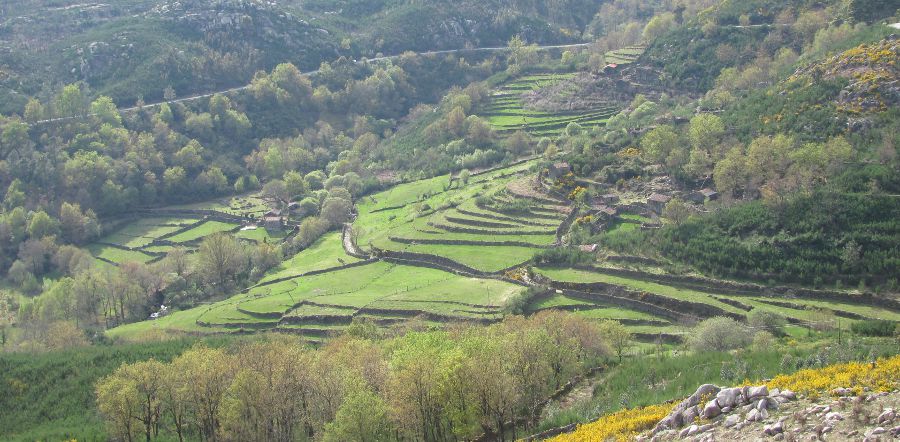
That is the case of "Branda da Bordença", located near the Adrão and Our Lady of Peace in Soajo.
This village that once was a "Branda" is now completely abandoned, except for a few cattle grazing. The houses formerly inhabited by men now serve only as shelter to the animals.
Here you can walk freely through the old houses and fields and relive the lifestyle of the ancient population.
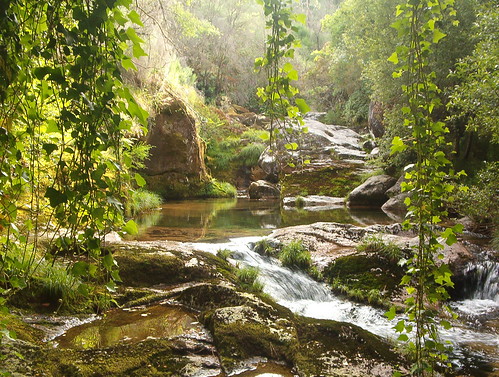
Cache
Waypoint 1 - Ponte Medieval
N 41° 54.432 W 8° 15.666
 |
 |
|
Neste local podem apreciar algumas casas e uma ponte medieval.
Neste ponto terão ao chegar à ponte de olhar para tras e conte quantas casas (A) (construções individuais) estão nessa àrea
|
At this site can view a few houses and a medieval bridge.
At the bridge back and take note of how many houses (individual buildings) (A) can you see.
|
Waypoint 2 - Casa antiga.
N 41° 54.486 W 8° 15.565
 |
 |
|
Depois dirija-se a este ponto onde vai encontra algumas casas.
Entre na que tem uma porta de madeira e conte o número de barrotes (B) que o telhado tem. Os barrotes são os que estão inclinados, veja a imagem
|
Next go to this waypoint where you will find some houses
Enter the house with the wooden door and count the number of beams (B) that the roof has. The beams are the ones who are inclined, see picture.
|
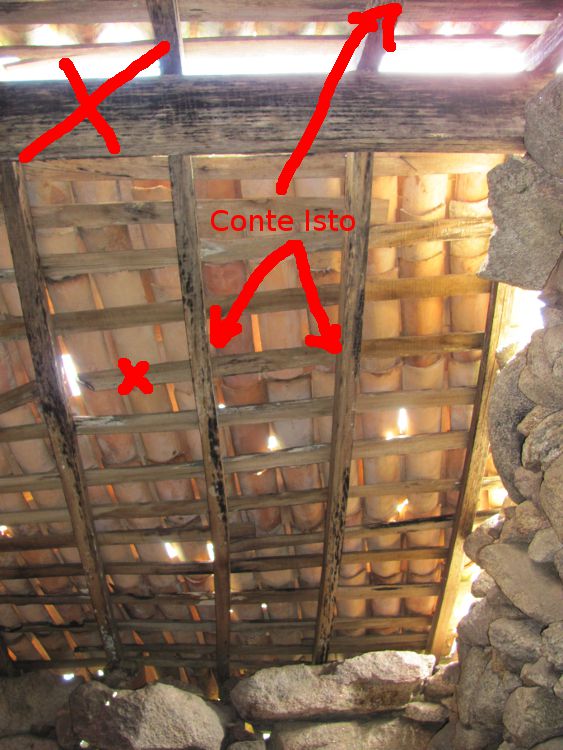
Exemplo de barrotes / beams example.
Waypoint 3 - Objectos perdidos
N 41° 54.485 W 8° 15.617
 |
 |
|
Neste local existe uma casa antigamente habitada.
Junto à porta de cima existe uma ferradura espetada na parede da casa. Conte o número de buracos (C) que contém.
|
Here there is an old house.
Near the upper door, there is a horseshoe stuck on the wall of the house. Count the number of holes (C) it contains.
|
Waypoint 4 - Estilo arquitectónico
N 41° 54.518 W 8° 15.734
 |
 |
|
Se ainda não reparou no estilo arquitectónico semelhante de praticamente todas as casas.
Veja agora e repare que contém espaço para as pessoas e gado usando dois difrentes andares.
Neste local está rodeado de algumas casas (uma em ruínas).
Conte quantas portas de metal (chapa) (D) tem elas no total.
|
If you have not noticed a similar architectural style of almost all the houses.
Look now and notice that each house contains space for people and cattle using two difrent flors
Here you are surrounded by some houses (one in ruins)
Count how many plate doors (D) they have in total.
|
Waypoint 5 - Espigueiro
N 41° 54.522 W 8° 15.626
 |
 |
|
De seguida desloque-se ao espigueiro localizado nestas coordenadas.
Dentro do espigueiro tem algumas construções de pedras abandonadas.
Anote o seu número (E), não conte as pedras do próprio espigueiro nem as pedrinhas pequenas apenas os objectos "grandes" que estão dentro dele.
|
Next go to the granary at this coordinates
Inside the granary there are some abandoned constructions made of stones.
Count how many they are (E), do not count the stones of the granary itself or the small pebbles only the "big" objects that are inside it.
|
Waypoint 6 - Ribeiro
 |
 |
|
Neste ponto vai encontrar um objecto com as coordenadas da cache
Para chegar as este ponto terá que usar a seguinte fórmula:
N 41º 54. (A + B + C + 540)
W 08º 15. (B + D + E + 458)
|
In this spot you will find an object with the coordinates of the cache
To get to this point will have to use the following formula:
N 41º 54. (A + B + C + 540)
W 08º 15. (B + D + E + 458)
|
Refrence Point - Senhor da Paz
N 41° 54.579 W 8° 15.274
 |
 |
|
Antes de ir para o ponto final passe por este local, onde se encontra a capela do Senhor da Paz, local de fé do povo da região que organiza uma peregrinação ao local em 27 de Maio.
Aceda ao ponto final por o trilho que inicia aqui em direcção ao monte.
|
Before going to the cache spot you will pass through this place, here you can see the chapel of Our Lord of Peace ("Senhor da Paz"), place of faith in the region.
To reach the cache pick the trail that starts here towards the summit.
|
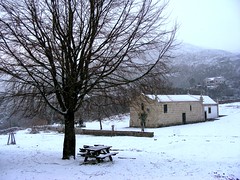
Senhor da Paz.
Final
 |
 |
|
Aqui aprecie os locais por onde passou para completar esta cache e contemple as belas serras do Minho.
Se tiver duvidas contacte-me, pode obter o meu número enviando-me um e-mail ou tomando nota dele em qualquer uma das minhas caches.
|
Here view the places you have been to complete this cache and admire the beautiful mountains of Minho.
If you have any doubt contact me, you can get my number by sending me an e-mail or taking note of it in any of my caches.
|